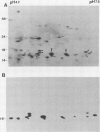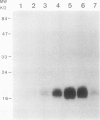Abstract
Two major polypeptides of the 15- to 18-kilodalton class of soybean (Glycine max) heat shock proteins (HSPs), obtained from an HSP-enriched (NH4)2SO4 fraction separated by two-dimensional polyacrylamide gel electrophoresis, were used individually as antigens to prepare antibodies. Each of these antibody preparations reacted with its antigen and cross-reacted with 12 other 15- to 18-kilodalton HSPs. With these antibodies, the accumulation of the 15- to 18-kilodalton HSPs under various heat shock (HS) conditions was quantified. The 15- to 18-kilodalton HSPs began to be detectable at 35° C, and after 4 hours at 40° C they had accumulated to a maximum level of 1.54 micrograms per 100 micrograms of total protein in soybean seedlings and remained almost unchanged up to 24 hours after HS. Accumulation of the HSPs was reduced at temperatures higher than 40° C. At 42.5° C the HSPs were reduced to 1.02 micrograms per 100 micrograms, and at 45° C they were hardly detectable. A brief HS at 45° C (10 minutes), followed by incubation at 28° C, which also induced HSP synthesis, resulted in synthesis of this class of HSPs at levels up to 1.06 micrograms per 100 micrograms of total protein. Taking into consideration the previous data concerning the acquisition of thermotolerance in soybean seedlings, our estimation indicates that the accumulation of the 15- to 18-kilodalton HSPs to 0.76 to 0.98% of total protein correlated well with the establishment of thermotolerance. Of course, other HSPs, in addition to this group of proteins, may be required for the development of thermotolerance.
Full text
PDF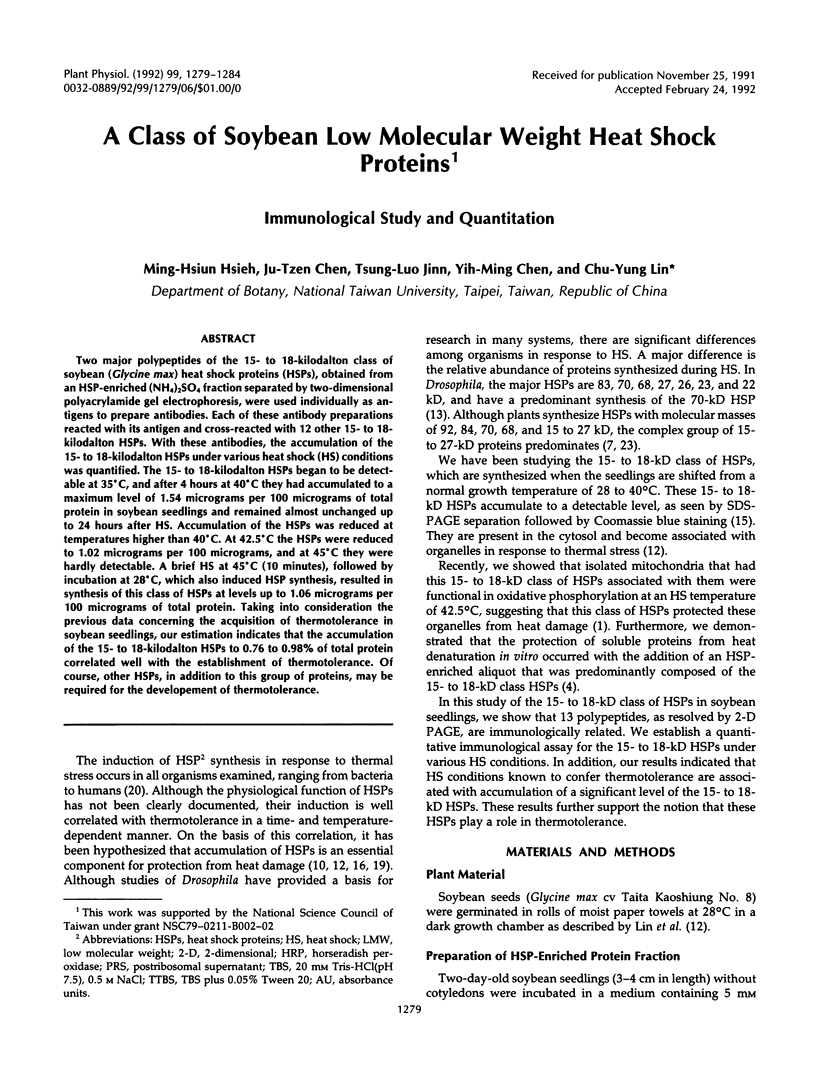
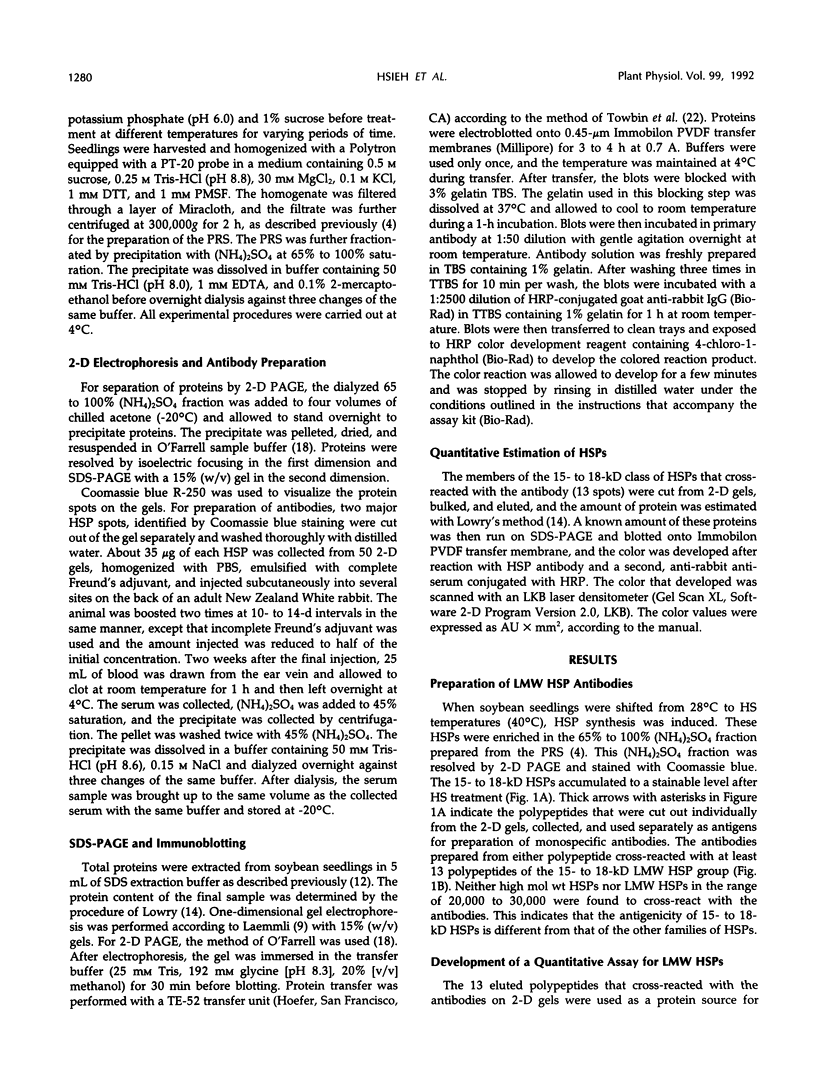
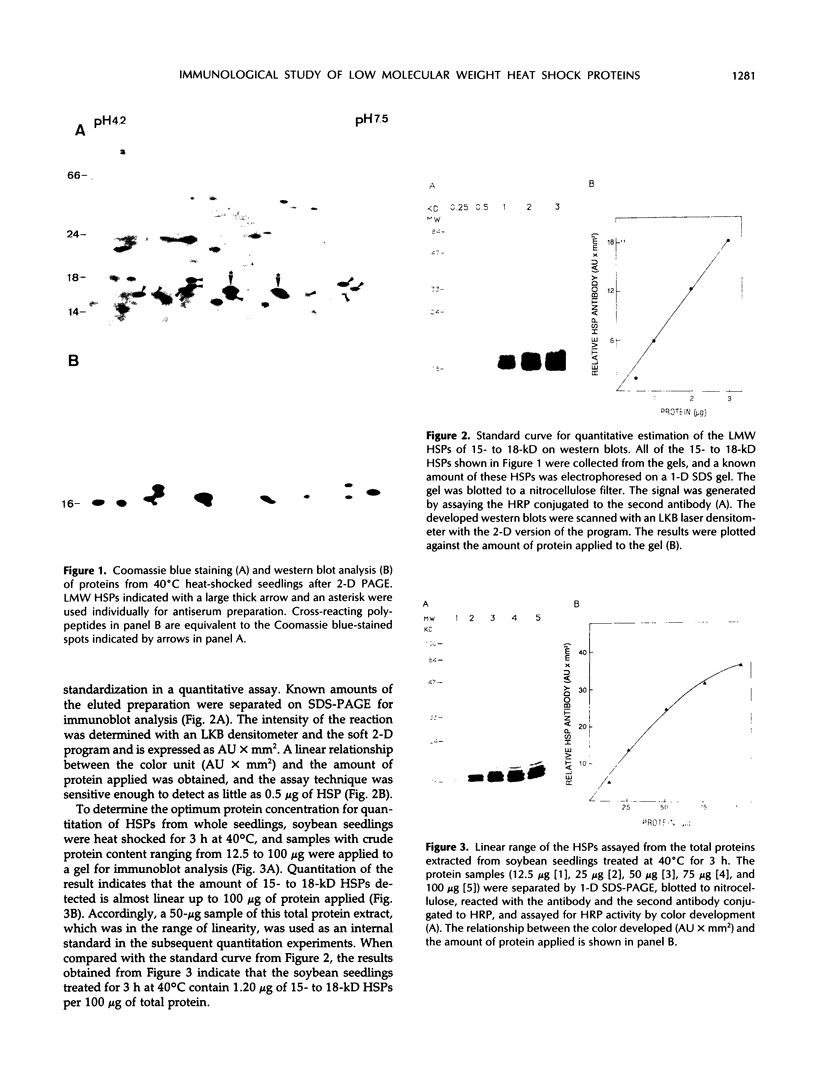
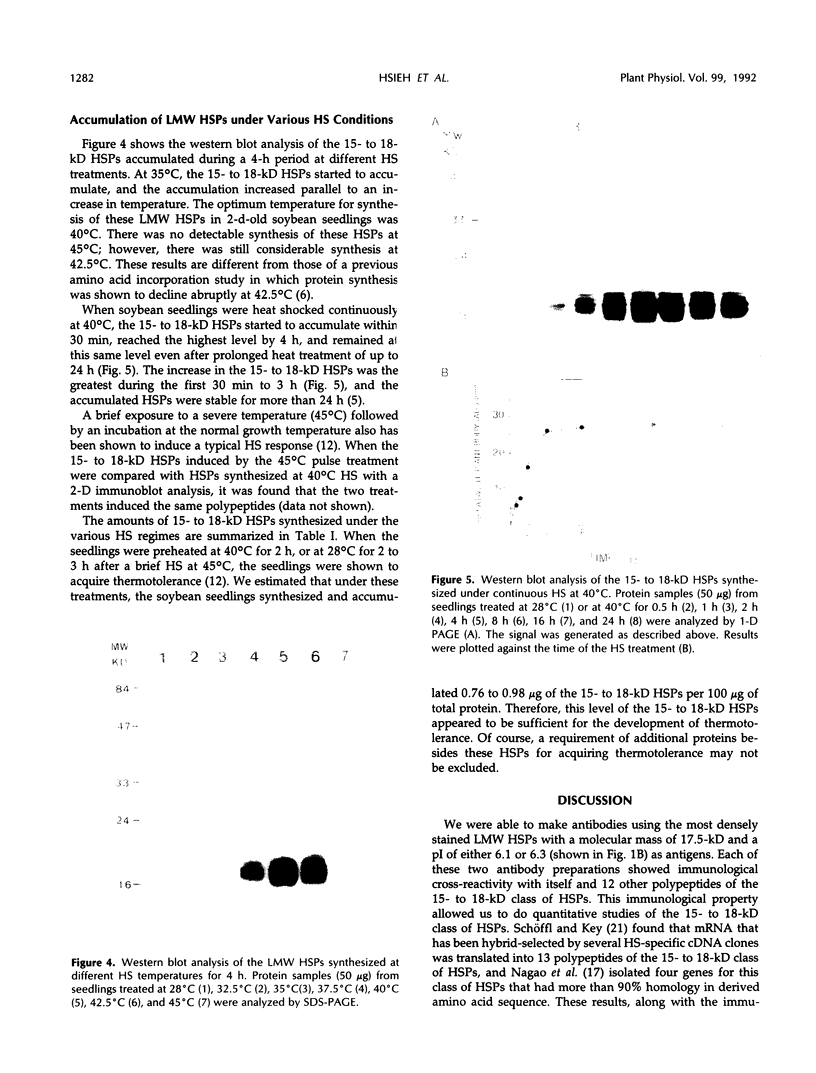
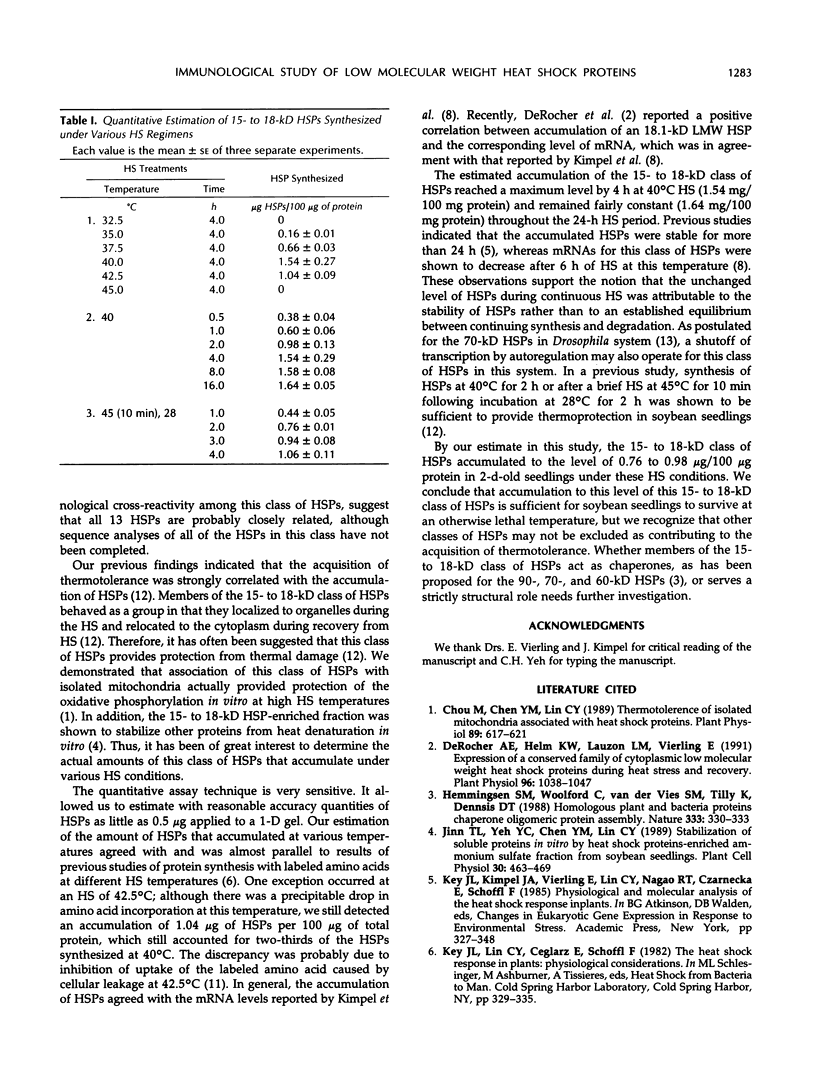
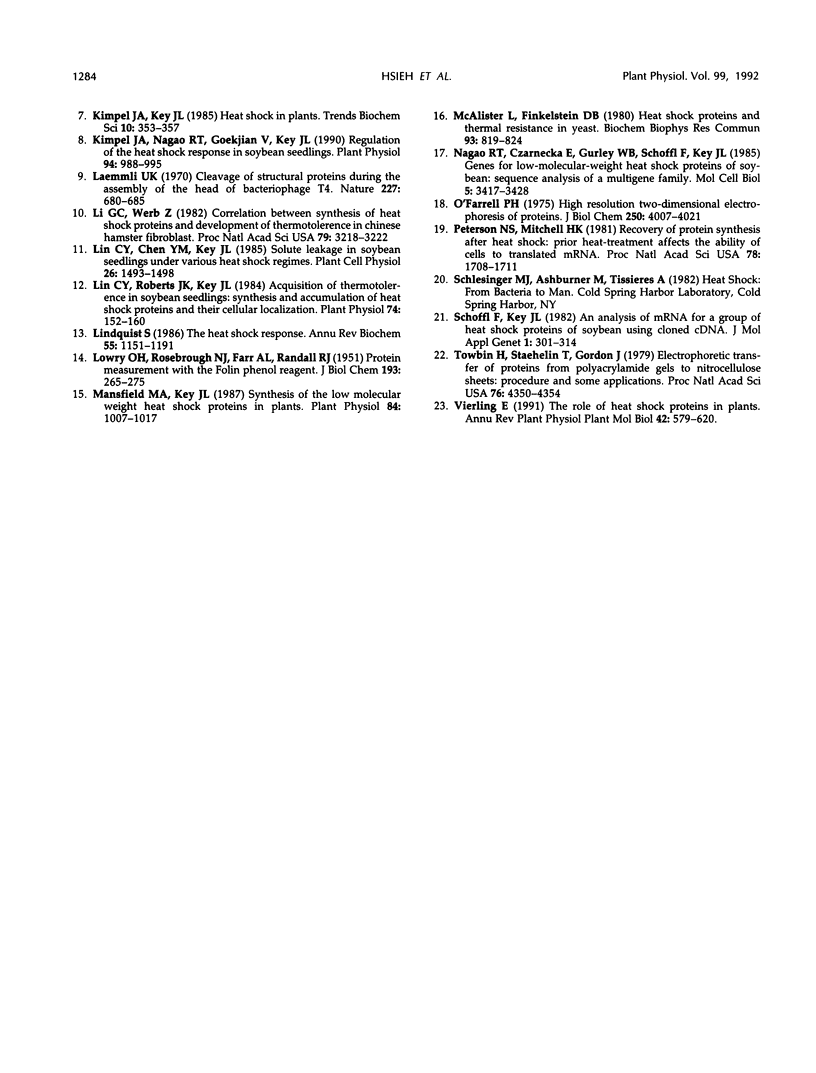
Images in this article
Selected References
These references are in PubMed. This may not be the complete list of references from this article.
- Chou M., Chen Y. M., Lin C. Y. Thermotolerance of isolated mitochondria associated with heat shock proteins. Plant Physiol. 1989 Feb;89(2):617–621. doi: 10.1104/pp.89.2.617. [DOI] [PMC free article] [PubMed] [Google Scholar]
- Derocher A. E., Helm K. W., Lauzon L. M., Vierling E. Expression of a Conserved Family of Cytoplasmic Low Molecular Weight Heat Shock Proteins during Heat Stress and Recovery. Plant Physiol. 1991 Aug;96(4):1038–1047. doi: 10.1104/pp.96.4.1038. [DOI] [PMC free article] [PubMed] [Google Scholar]
- Hemmingsen S. M., Woolford C., van der Vies S. M., Tilly K., Dennis D. T., Georgopoulos C. P., Hendrix R. W., Ellis R. J. Homologous plant and bacterial proteins chaperone oligomeric protein assembly. Nature. 1988 May 26;333(6171):330–334. doi: 10.1038/333330a0. [DOI] [PubMed] [Google Scholar]
- Kimpel J. A., Nagao R. T., Goekjian V., Key J. L. Regulation of the heat shock response in soybean seedlings. Plant Physiol. 1990 Nov;94(3):988–995. doi: 10.1104/pp.94.3.988. [DOI] [PMC free article] [PubMed] [Google Scholar]
- LOWRY O. H., ROSEBROUGH N. J., FARR A. L., RANDALL R. J. Protein measurement with the Folin phenol reagent. J Biol Chem. 1951 Nov;193(1):265–275. [PubMed] [Google Scholar]
- Laemmli U. K. Cleavage of structural proteins during the assembly of the head of bacteriophage T4. Nature. 1970 Aug 15;227(5259):680–685. doi: 10.1038/227680a0. [DOI] [PubMed] [Google Scholar]
- Li G. C., Werb Z. Correlation between synthesis of heat shock proteins and development of thermotolerance in Chinese hamster fibroblasts. Proc Natl Acad Sci U S A. 1982 May;79(10):3218–3222. doi: 10.1073/pnas.79.10.3218. [DOI] [PMC free article] [PubMed] [Google Scholar]
- Lin C. Y., Roberts J. K., Key J. L. Acquisition of Thermotolerance in Soybean Seedlings : Synthesis and Accumulation of Heat Shock Proteins and their Cellular Localization. Plant Physiol. 1984 Jan;74(1):152–160. doi: 10.1104/pp.74.1.152. [DOI] [PMC free article] [PubMed] [Google Scholar]
- Lindquist S. The heat-shock response. Annu Rev Biochem. 1986;55:1151–1191. doi: 10.1146/annurev.bi.55.070186.005443. [DOI] [PubMed] [Google Scholar]
- Mansfield M. A., Key J. L. Synthesis of the low molecular weight heat shock proteins in plants. Plant Physiol. 1987 Aug;84(4):1007–1017. doi: 10.1104/pp.84.4.1007. [DOI] [PMC free article] [PubMed] [Google Scholar]
- McAlister L., Finkelstein D. B. Heat shock proteins and thermal resistance in yeast. Biochem Biophys Res Commun. 1980 Apr 14;93(3):819–824. doi: 10.1016/0006-291x(80)91150-x. [DOI] [PubMed] [Google Scholar]
- Nagao R. T., Czarnecka E., Gurley W. B., Schöffl F., Key J. L. Genes for low-molecular-weight heat shock proteins of soybeans: sequence analysis of a multigene family. Mol Cell Biol. 1985 Dec;5(12):3417–3428. doi: 10.1128/mcb.5.12.3417. [DOI] [PMC free article] [PubMed] [Google Scholar]
- O'Farrell P. H. High resolution two-dimensional electrophoresis of proteins. J Biol Chem. 1975 May 25;250(10):4007–4021. [PMC free article] [PubMed] [Google Scholar]
- Petersen N. S., Mitchell H. K. Recovery of protein synthesis after heat shock: prior heat treatment affects the ability of cells to translate mRNA. Proc Natl Acad Sci U S A. 1981 Mar;78(3):1708–1711. doi: 10.1073/pnas.78.3.1708. [DOI] [PMC free article] [PubMed] [Google Scholar]
- Schöffl F., Key J. L. An analysis of mRNAs for a group of heat shock proteins of soybean using cloned cDNAs. J Mol Appl Genet. 1982;1(4):301–314. [PubMed] [Google Scholar]
- Towbin H., Staehelin T., Gordon J. Electrophoretic transfer of proteins from polyacrylamide gels to nitrocellulose sheets: procedure and some applications. Proc Natl Acad Sci U S A. 1979 Sep;76(9):4350–4354. doi: 10.1073/pnas.76.9.4350. [DOI] [PMC free article] [PubMed] [Google Scholar]



